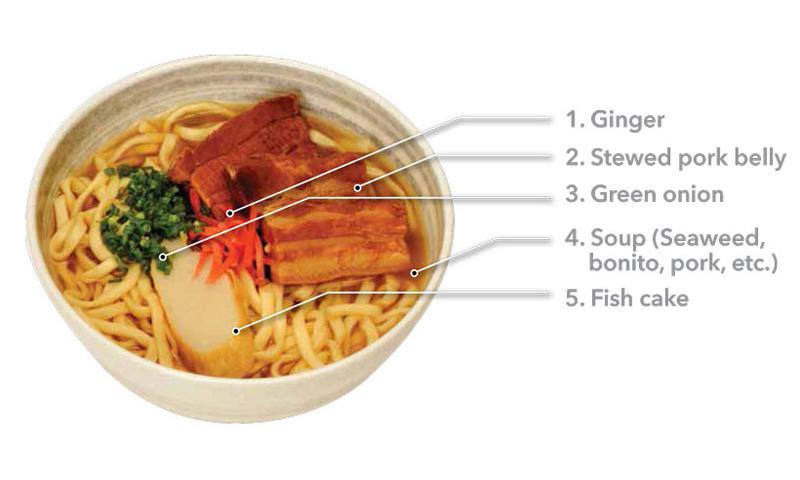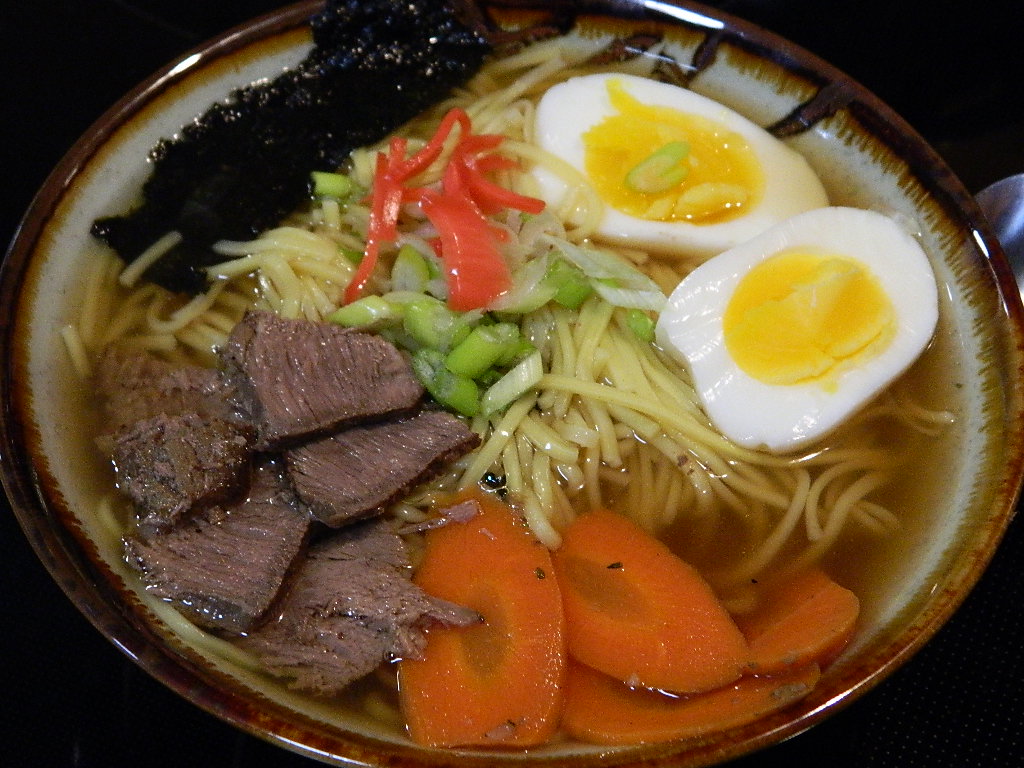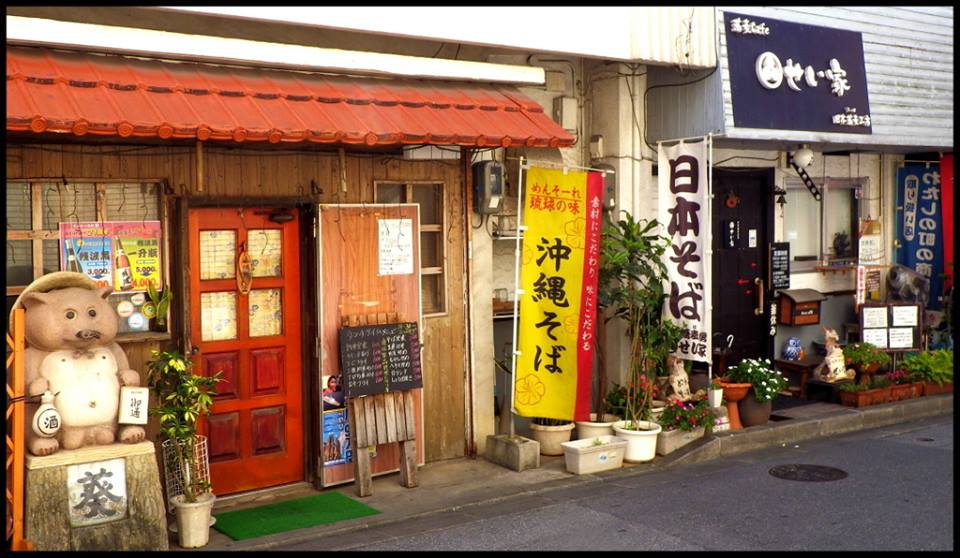
|
|
Okinawa Soba
Sept 27, 2018
|
In Japan, everybody loves noodles, and Okinawans are no different. In fact, they’ve got their own regional strand of the classic Asian cuisine – Okinawa soba. It’s not only a local favorite, but the dish of choice for many visitors who come in search of a true taste of Okinawa. The uninitiated may think Okinawa soba is some mere local take on those Japanese buckwheat noodles that can be slurped in just about any other corner of the country. But they’re wrong. This is a whole different dish.

Called “suba” in the local dialect, Okinawa soba is made from wheat flour instead of “sobako,” or buckwheat, like its counterpart from up north. The noodle is a little flatter and thicker compare to Chinese noodles. The color ranges from white to light yellow. As the matter of fact, the shape and the style of Okinawa soba noodles vary from island to island within the prefecture. For example, the Yaeyama Islands soba noodles tend to have a slight circular cross shape. The soup is flavored with seaweed, bonito flakes and pork, which is cooked for many hours and very carefully skimmed. Standard toppings include fish cake, green onion and a thick slice of stewed pork belly (“san-mai niku”) or pork rib (“soki”); while the dish is usually garnished with red pickled ginger. Boiled pig’s feet, or “tebichi,” and pork cartilage are also popular toppings. Want an extra kick to your soba? Add some “koregusu,” a popular condiment made of hot-chili-infused local “awamori” liquor. Each Okinawa soba restaurant has its own variation of broth and toppings, such as tofu, giblets or fried vegetables. In many restaurants, you can ask for a mix of various toppings according to preference to make your own original bowl of Okinawa soba. Prices usually vary between 500 to 800 yen ($5 to $8). It’s so tasty, and the tender pork belly soaked in rich broth just melts in your mouth. The meat is well braised until tender enough to be cut by chopstick. The boiled noodle is chewy and goes well with the soup. It is addictive. It is loved so much, in fact, that more than 190,000 bowls are consumed each day in Okinawa, according to the Okinawa Fresh Noodle Cooperative Association. “Okinawa soba is very unique because the soup is a combination of Chinese influenced broth made from pork and Japanese influenced broth made from “bonito” (dried fish flakes),” says Atsunori Sunagawa, executive secretary of the cooperative. “Today, people don’t make home-made Okinawa soba much because the noodles and soup can be purchase at grocery stores – and there are more than 300 restaurants that specialize in it.” It is said that the local love affair with noodles started in the early 1500s when they were first imported from China to the Ryukyu Kingdom. During the Meiji Era (1868-1912), they began gaining popularity, but were still considered a luxury food. Over time, however, the growing popularity of noodles gave birth to the local version that Okinawans of all ages today have come to know and love. How much? Consider this: Every year for the past decade and a half, Okinawa has been celebrating Okinawa Soba-no-Hi, or Okinawa Soba Day on Oct. 17. On this auspicious day, events honoring all things soba take place throughout Okinawa. Some shops even handout soba free of change. Soba restaurants tout special menu items and discounts; and an estimated 2,000 other eateries showcase soba on their menus for Okinawa Soba Day. But why wait till October? Okinawa soba restaurants are almost everywhere in Okinawa. It is quick, inexpensive and tasty. Get your bowl of authentic Okinawa soba – for a true taste of Okinawa! For more on Okinawa’s soba story (in Japanese), visit www.oki-soba.jp/about/okisoba.html. So(ba), what’s in a name? There is more to how Okinawa soba got its name than just its place of origin. Not long after the postwar reversion of Okinawa to the Japanese government in 1972, the mainland organization governing fair trade claims insisted that, according to its rules, Okinawan soba could not be sold as soba because it did not meet the minimum criteria. According to Japan’s Fair Trade Commission, soba noodles must be comprised of at least 30 percent buckwheat. Traditional Okinawan-made soba noodles, however, have always been made with 100 percent wheat. Many Okinawans protested the rule. In a bid to protect their traditional dish as well as livelihoods, Okinawa soba producers and the Okinawa Noodle Maker’s Union fought to have it changed. After lengthy negotiations, the Japanese government finally agreed to a compromise: It could be called, and hence sold, under the special name of “Okinawa soba.” Oct. 17, 1978 was the day that Okinawa soba was finally, officially endorsed. Okinawans, not only celebrated the day as a victory, they made it a local holiday to honor the traditional dish and promote the local industry. Okinawa Soba-no-Hi, or Okinawa Soba Day has been celebrated throughout the prefecture on Oct. 17 ever since. Know your noodles: Names of local soba favorites
“Okinawa Soba”
“Soki Soba”
“Tebichi Soba”
“Nakami Soba”
“Yasai Soba”
“Yushi Tofu Soba”
* Yushi tofu is coagulated, unformed Okinawa-style tofu (Shima tofu) that is eaten warm. Similar to “oboro tofu” in other parts of Japan, it’s favored for its rich soy taste. This tofu served in soba noodles, it is a popular dish on Okinawa. Have a side of ‘Jushi’ “Jushi” is a rice dish prepared with a choice of ingredients, including pork and vegetables and is often served as a side dish with Okinawa soba. Each restaurant uses their own original broth to cook the rice. “Fuchiba jushi” is jushi with “fushiba,” or mugwort leaves. Source: Stripes Okinawa, September 26, 2018 
Here's a bowl of a tasty Okinawan delight that I created myself. |
A SHORT HISTORY OF THE SOBA WAR BETWEEN OKINAWA AND JAPAN !
Holy Smokes !!! Stars & Stripes left out the best part of the story. That means I'm forced to post it here, so I'll be able to sleep tonight ! As mentioned in the Stripes, "Soba" is the Japanese word for "buckwheat". However, Okinawa Soba noodles contain NO buckwheat—they are made entirely from regular wheat. Despite the name, buckwheat is not related to wheat. Instead, buckwheat is related to sorrels, knotweeds, and rhubarb. THE JAPANESE START TO MEDDLE (AS USUAL) IN OKINAWAN AFFAIRS After Okinawa became Japan's 47th Prefecture (again) when the USA returned the islands to Japanese control in 1972, the Japan Soba-Growers' Association tried to force Okinawa drop the name "Soba" from their noodle dishes. This was because, according to the mainland "Japanese Regulations on the Naming of Noodles", a noodle must contain at least 30% buckwheat in order to bear the name "Soba." However, the Okinawans refused to (1) adulterate their classic noodles with buckwheat, and (2) refused to drop the name "Soba". Instead, they took the Japanese to task. THE OKINAWAN ARGUMENT Okinawa answered the Japanese Soba Growers Association, using the solid argument that throughout Japan the word "Soba" was ALREADY USED in many instances to mean noodles in general, including noodles that had NO buckwheat at all --- something the Japanese Soba-Growers association completely and conveniently forgot about in their zeal to stamp out "Okinawa Soba". FOR EXAMPLE : While pushing Okinawa around for using the word "Soba" for buckwheat-free noodles, throughout the REST of Japan they allowed "Shina Soba" and "Chuka Soba" --- both meaning "Chinese Soba" --- as alternate terms for "Ramen", which was also made with plain wheat flour. Further, throughout the mainland, the ever-popular "Yaki Soba" (stir-fried Chinese noodles) also contains no buckwheat at all, yet the Japanese still call it "Soba". JAPAN TO OKINAWA : DO AS WE SAY, NOT AS WE DO !!! The Japanese Soba-Growers Association --- who allowed the word Soba in these other cases of 100% Wheat Flour noodles --- refused to consider these already-established mainland exceptions, pushing forward with their fanatical mission to rid the land of the offensive "Okinawa Soba" noodle name. In other words, the Japanese Soba-Growers Association --- just like the rest of the mainland Japanese corporations, associations, and the central government --- are always blind to (and forgiving of) their own self-centered inconsistencies, while looking for ways to walk all over the Okinawans and their ancient culture, in an attempt deny them the very things the Japanese allow for themselves. OKINAWA WINS THE CASE -- JAPAN BACKS DOWN In the end, the Okinawa Soba makers won an exception to the Japanese rule, and the mainland "Soba Growers Association" was forced to swallow their hypocrisy. OKINAWA POKES BACK, After that, the Okinawans have poked back at the mainlanders for their ignorant and hypocritical goofiness. This has resulted in a "Soba Sign War" that today is found only on Okinawa. The Wikipedia says, ".....if one wants to eat buckwheat noodles in Okinawa, one must generally look for a sign or a menu listing that says "Japanese Soba" (Nihon Soba) ---- rather than just plain "Soba", as would be seen throughout the rest of Japan...." Even with a 100:1 population ratio against the ethnic Okinawans --- Japan still has to work hard to keep Okinawa in check on all matters of culture and education. Otherwise, your average Okinawan will easily win an argument against your average Japanese main-lander, and an Okinawan Karate Master will always knock a Japanese Judo Master flat on his ass !!! Cheers !
Bonus Photo : A neighborhood SOBA WAR in Kadena --- Okinawa Soba Shop on the LEFT, and a Japanese Soba Shop on the RIGHT. The Japanese Soba Shop went out of business. Long Live Okinawa Soba !!! Rob Oechsle (Facebook post 9-27-18) |
©2018 Contact: ClickOkinawa.com

